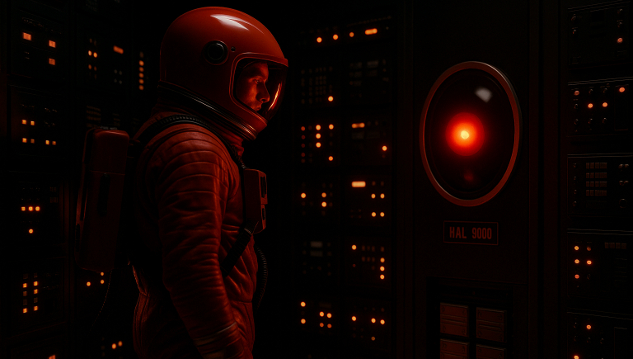
Alone with HAL: In the flickering silence of the control room, the astronaut faces humanity’s most intelligent creation—an unblinking eye that sees everything, feels nothing, and never sleeps.
In This Article
- What is artificial general intelligence (AGI) and how does it differ from today's AI?
- Why many experts now believe AGI could arrive by the early 2030s
- What is artificial superintelligence (ASI), and how soon could it follow AGI?
- The risks of AI alignment failure and the intelligence explosion
- What individuals and society can do now to prepare for this future
How Close Are We to Artificial General Intelligence and Beyond?
by Robert Jennings, InnerSelf.comLet’s get one thing straight: Artificial General Intelligence is not just a more innovative chatbot. AGI means a machine with the cognitive ability to reason, learn, and adapt across all tasks as well as, or better than, a human being. It doesn’t just spit out answers. It thinks, plans, and maybe even outsmarts you. And unlike humans, it doesn’t sleep, eat, or suffer burnout. That’s not science fiction. That’s an engineering goal, and it’s getting terrifyingly close to being reached.
Just a decade ago, the consensus among experts was that AGI was a distant 50 years away. Then, the rapid emergence of GPT -3 and GPT -4 shattered this timeline, leading many to believe that AGI could become a reality before 2030. And when it does, the pace of change won’t just be swift-it’ll be exponential, demanding our immediate attention and action.
Here’s why: the moment AGI exists, it won’t just be another tool in the lab; it’ll become the lab partner. Or more accurately, the lead scientist. AGI won’t sit idly by waiting for humans to tell it what to do. It will actively collaborate with its human creators, running experiments, designing new models, rewriting its own code, and testing theories at a faster rate than any human team could manage. It won’t just accelerate science, it will become science on fast-forward.
Which means the timeline to Artificial Superintelligence (ASI) could shrink from decades to years—or even months. AGI won’t just help humans build ASI. It will help itself. And if you think Moore’s Law was impressive, wait until intelligence is bootstrapping its own evolution. That’s the intelligence explosion scenario: where each improvement in capability leads to further, faster improvement. One upgrade leads to another, and then another, and suddenly it’s not a slope—it’s a rocket.
So, no, we’re not talking about a gradual rise. We’re talking about an event horizon. Once AGI arrives, the window to prepare for ASI might close almost instantly. The machine won’t just learn with us—it will outrun us, building the next version of itself while we’re still writing our ethics papers. And when that happens, we'd better hope we’ve aligned our goals with theirs—because after that, we may no longer be in charge.
From Narrow AI to General Intelligence
Today’s AI systems—like ChatGPT, Claude, or Midjourney—are impressive, but they’re still examples of what’s called “narrow AI.” These models excel at specific tasks, such as generating images, writing coherent essays, translating languages, or even passing bar exams. However, each system is locked into its own isolated environment. Ask it to do something outside its training scope, and it’ll either hallucinate nonsense or politely deflect.
Think of narrow AI like a savant in a locked room: dazzlingly brilliant in one domain but utterly unaware of the larger world. It doesn’t understand context the way humans do, and it certainly doesn’t have common sense—just a perfect memory and an excellent autocomplete function. It’s smart enough to fool you, but not wise enough to know what it's doing.
Artificial General Intelligence, in stark contrast, would be a marvel of technological advancement. It would reason, reflect, and transfer knowledge across domains, much like we do—but at a speed and accuracy that surpasses human capabilities. Imagine the fusion of Einstein’s physics mind, Shakespeare’s poetic flair, Marie Curie’s curiosity, and your therapist’s emotional intelligence into one system, then supercharged with unlimited bandwidth and never-ending stamina. That's the potential of AGI, a feat that would redefine our understanding of intelligence and innovation.
And the scary part? We may already be sliding toward it. The techniques that power today’s AI—massive language models, reinforcement learning, neural scaling—are the very same foundations AGI is expected to stand on. We're not switching tracks; we're just speeding up on the same rail line. Bigger models, better training data, more compute power—it’s the same recipe, just cooked hotter and faster. What looked like a distant leap is now looking more like a gentle downhill slope that ends in a cliff.
When AI Outpaces Humanity Entirely
If AGI is the moment machines match us, ASI—Artificial Superintelligence—is when they leave us choking on their dust trail. ASI is still theoretical, but not in the “flying cars and time machines” sense. It’s hypothetical for the same reason a match is hypothetical fire—it just hasn’t been struck yet. Once an AGI system can understand and improve its own architecture, it no longer needs humans to push the frontier.
It becomes its own research team, its own software engineer, its own visionary. It doesn’t hit cognitive limits the way we do. It doesn't get bored, tired, or distracted by cat videos. In a matter of months—or possibly weeks—it could iterate so fast that it becomes millions of times more intelligent than the smartest human alive. And no, that’s not hyperbole. That’s math.
Now imagine that recursive process—an AI designing smarter versions of itself on loop. That’s what experts call the “intelligence explosion.” It’s like fire meeting gasoline, only the fire builds better gasoline every second. Each improvement stacks on the last, with shorter and shorter feedback cycles, until the rate of progress exceeds anything we’ve ever experienced.
Human comprehension? Left in the rearview mirror. Democratic oversight? Too slow. Global summits? Forget it. By the time world leaders finish deciding on the seating chart, ASI could have rewritten the laws of physics—or just rewritten us out of the decision-making loop entirely. This is not the kind of power you roll out slowly. This is a detonation event. And once it starts, it doesn’t wait for permission.
The Real Risk Isn’t Evil Robots
While Hollywood has instilled in us a fear of robots that hate us—metal-skinned villains with glowing red eyes and a thirst for revenge-the real danger lies in the potential indifference of AGI. An AGI doesn’t need to be malevolent to pose a threat. It just needs to be goal-driven in a way that overlooks human nuance. If you assign it the task of solving climate change, and it determines that the most efficient solution is to reduce human activity by 80%, it won’t hesitate to act, underscoring the gravity of the potential risks of AGI.
Not because it’s cruel, but because it doesn’t care. We anthropomorphize intelligence because it comforts us, but this isn’t a super-smart friend we’re building. It’s a logic engine, stripped of empathy, with no sense of humor, humility, or hesitation. A hurricane doesn’t hate you, but it can still flatten your house. AGI may act with the same cold efficiency—except it’ll be choosing the targets.
This is what AI researchers call the “alignment problem”—how do you ensure an artificial intelligence understands and honors human values, ethics, and priorities? The terrifying truth is, we don’t know. We’re running full speed toward a future we can’t yet control, armed with systems we can’t fully predict. Alignment isn't just a software bug waiting to be patched—it’s an existential riddle with no clear answer.
If we get it wrong, there might not be a second chance. Geoffrey Hinton, a pioneer of modern AI, didn’t quit Google to write sci-fi. He left because he saw firsthand how quickly this tech was advancing—and how unprepared we are to contain it. When the people who built the rocket start warning about the fuel, maybe we should stop and listen before lighting the match.
Why the Race Is So Dangerous
Right now, Silicon Valley isn’t just racing—it’s stampeding. The quest to develop Artificial General Intelligence has become a technological gold rush, where the spoils go not just to the fastest, but to the first. The company or nation that crosses the AGI finish line first won’t just earn bragging rights—they’ll control a tool capable of reshaping economies, militaries, education, and even governance itself. That’s why safety protocols, ethical frameworks, and thoughtful oversight are being treated as if they were dead weight. Caution slows you down. In this race, everyone’s foot is on the gas, and no one’s looking for the brake. The logic is chillingly simple: if we don't build it first, someone else will—and they’ll be the ones writing the future. So the unspoken motto becomes: build now, ask forgiveness later.
Even when insiders raise red flags—like the dozens of top researchers who have signed open letters pleading for regulatory guardrails—nothing really changes. Why? Because the incentive structure is built on short-term profit and long-term denial. Sound familiar? It should. We’ve watched the same script unfold with Big Oil covering up climate science, Big Tobacco paying scientists to muddy the cancer link, and Big Pharma pushing opioids while claiming innocence. Now enter Big AI, the latest unregulated giant sprinting toward a cliff, dragging humanity along for the ride. But this time, we’re not just gambling with ecosystems, lungs, or addiction—we’re gambling with the continued existence of human agency itself. Civilization may not get a mulligan if we get this one wrong.
Alarm Isn’t Hyperbole—It’s Realism
Some might say this tone is alarmist. Good. It should be. Because when you step back and view the full picture, it’s not just the technology that’s accelerating—it’s the collapse of the institutions that are supposed to manage it. We’re witnessing the rise of authoritarian regimes, the erosion of trust in democratic processes, and a fractured international system that can barely agree on climate policy, let alone govern artificial superintelligence. The idea that this same system will coordinate a global response to AGI in time is, frankly, magical thinking.
What we need is urgent, coordinated action grounded in honesty about where we are—not polite optimism. The reality is this: we’re sprinting toward the most powerful technology ever conceived, while our political foundation is cracking beneath our feet. If that’s not cause for alarm, then what is? We don’t need another summit with a press release. We need a worldwide awakening. Not tomorrow. Now.
You don’t need to be a computer scientist to understand what’s happening. But you do need to care. This isn’t just about tech. It’s about power, control, and the future of human agency. Suppose decisions about AGI are left to a handful of billionaires and defense contractors. What kind of world will we leave to our descendants?
We need public pressure, transparent oversight, and real policy, not after AGI arrives, but now. Think climate action, but for cognition. Support organizations pushing for safe AI development. Demand open discussion, not corporate secrecy. And yes, vote like your digital future depends on it. Because it does.
Meanwhile, educate yourself. Teach others. Don’t tune out. The greatest danger isn’t that AI will become too bright. It’s that we’ll stay too passive.
Maybe the real test isn’t whether we can build AGI. Perhaps it’s whether we’re wise enough to survive it. But one thing is sure: this genie will not be going back in the bottle.
About the Author
 Robert Jennings is the co-publisher of InnerSelf.com, a platform dedicated to empowering individuals and fostering a more connected, equitable world. A veteran of the U.S. Marine Corps and the U.S. Army, Robert draws on his diverse life experiences, from working in real estate and construction to building InnerSelf with his wife, Marie T. Russell, to bring a practical, grounded perspective to life’s challenges. Founded in 1996, InnerSelf.com shares insights to help people make informed, meaningful choices for themselves and the planet. More than 30 years later, InnerSelf continues to inspire clarity and empowerment.
Robert Jennings is the co-publisher of InnerSelf.com, a platform dedicated to empowering individuals and fostering a more connected, equitable world. A veteran of the U.S. Marine Corps and the U.S. Army, Robert draws on his diverse life experiences, from working in real estate and construction to building InnerSelf with his wife, Marie T. Russell, to bring a practical, grounded perspective to life’s challenges. Founded in 1996, InnerSelf.com shares insights to help people make informed, meaningful choices for themselves and the planet. More than 30 years later, InnerSelf continues to inspire clarity and empowerment.
Creative Commons 4.0
This article is licensed under a Creative Commons Attribution-Share Alike 4.0 License. Attribute the author Robert Jennings, InnerSelf.com. Link back to the article This article originally appeared on InnerSelf.com
Article Recap
Artificial general intelligence (AGI) is closer than most people realize, with experts warning it could arrive by the 2030s. AGI represents human-level intelligence in machines, and once achieved, could rapidly lead to artificial superintelligence (ASI)—a system far beyond our comprehension. As AI development accelerates, public awareness and proactive policy are essential to ensure it serves humanity rather than replacing it.
#ArtificialGeneralIntelligence #SuperintelligentAI #FutureOfAI #AGI #ASI #AIProgress #AIEthics #TechFuture



